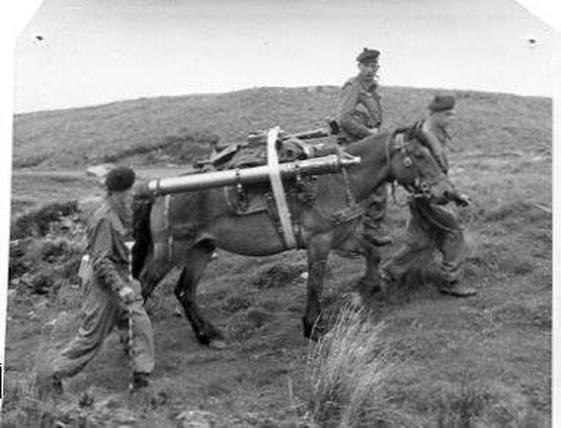From "Gallipoli troops with Bute, Cumbrae and Largs connections in World War I"
Britain's Territorial Army was a volunteer reserve of part-time citizen soldiers who would fight alongside friends and neighbours from their own district. Largs and Millport Territorials along with Rothesay men formed the Bute Mountain Battery of the 4th Highland (Mountain) Brigade of the Royal Garrison Artillery. That brigade was the only Territorial Force Artillery assigned (for 5 months) to the 29th Division. It used "screw guns" which were taken apart, transported on sturdy Highland ponies - sometimes even by the men themselves - and reassembled on sites inaccessible to guns with fixed wheels. This let them be used in front line firing positions, often on commanding heights, and too close to the enemy to cause "friendly fire".
The Brigade Batteries, along with the Ammunition Column (recruited in part at Millport), were mobilised in August 1914, trained at Bedford, and were sent into Active Service in March 1915. They went via Alexandria, where they acclimatised, to Gallipoli. Once they arrived in harbour at Mudros "the gunners felt … too much time was spent sweltering in their troop ships awaiting sailing orders", but they were able to have a practice at disembarking the ponies, thereby helping them to overcome the fear of "being pulled out of the hold of one ship and slung over the water to another before being placed on landing barges".
When the real attack took place on 25th April the Highland Gunners were the first artillery to land in support of the infantry. "The British forces … showed remarkable professionalism and courage … When the officers commanding a particular unit were killed, the resulting successions of command proceeded smoothly and quickly". As in other spheres of the war, local Scottish names were given by the gunners to their whereabouts, e.g. Kilkerran Road. Some "down time" was possible at the "not too far rear"; this allowed them to swim on the beaches - the only way to bathe [? = wash] - repair clothing and equipment, and relax with their comrades.
One new recruit appeared on the scene, Lady Gallipoli, daughter of one of the mares. While bringing some light and joy, "Polly" brought her own problems. The other ponies had to be given shorter rations to feed her and her mother. It was ordered that she be put down, but before that could happen the vet giving the order was himself killed on the way to see if it had been carried out. Lady Gallipoli survived the campaign !
Britain's Territorial Army was a volunteer reserve of part-time citizen soldiers who would fight alongside friends and neighbours from their own district. Largs and Millport Territorials along with Rothesay men formed the Bute Mountain Battery of the 4th Highland (Mountain) Brigade of the Royal Garrison Artillery. That brigade was the only Territorial Force Artillery assigned (for 5 months) to the 29th Division. It used "screw guns" which were taken apart, transported on sturdy Highland ponies - sometimes even by the men themselves - and reassembled on sites inaccessible to guns with fixed wheels. This let them be used in front line firing positions, often on commanding heights, and too close to the enemy to cause "friendly fire".
The Brigade Batteries, along with the Ammunition Column (recruited in part at Millport), were mobilised in August 1914, trained at Bedford, and were sent into Active Service in March 1915. They went via Alexandria, where they acclimatised, to Gallipoli. Once they arrived in harbour at Mudros "the gunners felt … too much time was spent sweltering in their troop ships awaiting sailing orders", but they were able to have a practice at disembarking the ponies, thereby helping them to overcome the fear of "being pulled out of the hold of one ship and slung over the water to another before being placed on landing barges".
When the real attack took place on 25th April the Highland Gunners were the first artillery to land in support of the infantry. "The British forces … showed remarkable professionalism and courage … When the officers commanding a particular unit were killed, the resulting successions of command proceeded smoothly and quickly". As in other spheres of the war, local Scottish names were given by the gunners to their whereabouts, e.g. Kilkerran Road. Some "down time" was possible at the "not too far rear"; this allowed them to swim on the beaches - the only way to bathe [? = wash] - repair clothing and equipment, and relax with their comrades.
One new recruit appeared on the scene, Lady Gallipoli, daughter of one of the mares. While bringing some light and joy, "Polly" brought her own problems. The other ponies had to be given shorter rations to feed her and her mother. It was ordered that she be put down, but before that could happen the vet giving the order was himself killed on the way to see if it had been carried out. Lady Gallipoli survived the campaign !
